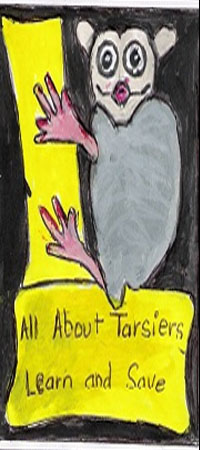|
Most of the tarsier species and subspecies are designated as threatened to some degree, with the exception of the three Philippine subspecies, lariang tarsier, pygmy tarsier, Wallace’s tarsier and Fisher’s tarsier, simply because of a lack of knowledge of their numbers and distribution. C. b. natunensis is designated as ‘critically endangered’ due to its very restricted range (less than 100km2) which leaves this subspecies vulnerable to habitat loss. For the western tarsiers 30% of their habitat has been lost over the last 20 years, although the impact of this is not really known. Tarsiers in this region are also at risk of capture for the pet trade which can remove important breeding individuals from the population. C. syrichta is listed as near threatened due to some habitat loss in the last 20 years, but because of its ability to live in secondary growth forests has been somewhat protected. This tarsier is also threatened by capture for the pet trade. The population sizes and conservation statuses of the Philippine subspecies are unknown, but species with restricted ranges may fair worse when faced with habitat loss. Of the eastern tarsiers, only T. tarsier, T. dentatus, T. tumpara, T. pelengensis and T. sangirensis have IUCN ratings and the other species are listed as data deficient or unknown. These species are also thought to be threatened by habitat loss and the conversion of forests to agricultural land. According to the IUCN, all of the species/subspecies of tarsier show a trend of decreasing population size. A major difficulty is the lack of specific knowledge of each of the tarsiers and their habitats and population sizes, along with the fact that there is still a lot of discussion over the differences between the species/subspecies and their names. The Siau Island tarsier is listed as Critically Endangered and as one of the world’s 25 most endangered primates, due to its very restricted island range (around 125km2) and proximity to humans.
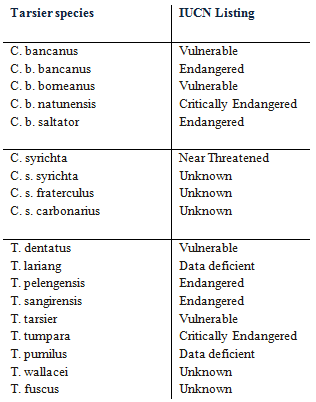
Threats
Tarsiers face a number of threats, most notably habitat loss or degradation, with many tarsiers losing more than half of their original habitat. In some areas much of the forest has been converted to agricultural use and this does not benefit tarsiers. Forests are often destroyed for palm or coffee plantations, mining, logged for timber or turned into grazing land. Most tarsiers can still live in secondary forests and in some degraded and cultivated areas but need access to enough sleeping sites to survive. Degraded areas can support fewer individuals and may not offer enough seclusion from humans. Tarsiers are also threatened by hunting or capture for the pet trade. Hunting tarsiers for food has been documented on Siau Island and may be one of the reasons why the Siau Island tarsier is so endangered. There have been reports of tarsiers suffering from the effects of pollutants near to agricultural areas including sickness, sores and low body weight. Endangered Species International (ESI) supports the ban of chemicals used in agriculture fields adjacent to tarsier habitat in the Philippines. Forests fires, natural disasters and human disturbances also harm tarsiers and restrict or destroy their habitat. Climate change may affect tarsiers or their habitats.
ESI Saving Tarsiers
Captive tarsier management is difficult and often unsuccessful due to their specific feeding habits and habitat needs. Over half of the tarsiers caught in the wild die within two years and infant mortality is high in captivity. Therefore, research and conservation efforts must be carried out in a wild setting. A lot of work has been carried out in the Philippines for the benefit of the Philippine tarsier – legislation has been passed to stop animals being taken from the wild and to stop habitat disruption, but often not respected. Tarsiers are illegally captured and shown to visitors. The Philippine tarsier foundation and sanctuary was set up in the island of Bohol and research carried out into the problems faced by tarsiers.
Endangered Species International (ESI) conducts research and conservation activities to protect tarsier and its habitat in southern Philippines thanks to the strong support of the local governments and communities. For our project, we work in close relationship with the Municipality of Tupi, the Province of South Cotabato, the Bl’aan indigenous people, and local non-profit organizations. Our project aims to protect existing habitat for tarsier, to extend forest cover, to protect remaining populations of tarsier, and provide sustainable livelihood alternatives that favor nature conservation. ESI also supports the creation of the Tarsier Sanctuary, a critical habitat designation that safeguards wild tarsiers and many other endemic plants and animals.
The Future
In the future more research needs to be carried out to find out the population sizes of each of the tarsiers and to implement effective conservation efforts. Agreement needs to be reached over the naming and organization of the species and groups of tarsiers to enable proper conservation to take place. Strong field efforts need to be conducted to stop habitat loss and cutting down of forests and to minimize disturbance to these animals. All species should be protected from illegal hunting and capture. Tarsiers should not be shown to the public as a pet like it is illegally practiced in the island of Bohol in the Philippines. Existing wildlife laws must be enforced and local groups must encourage the government to fulfill its mission to apply laws. Conservation education and awareness are essential to protect the tarsier and most areas occupied by tarsier lack educational programs about the environment and biodiversity. The impacts of chemical use for agriculture should be assessed on tarsier populations and other organisms. Without these efforts some tarsiers could be lost completely from the wild in this century.
Please Join us NOW to save tarsiers and rainforest! We cannot do it alone!
Acknowledgements
For the tarsier pages, we thank Rebecca Plant for her great work!
|
|
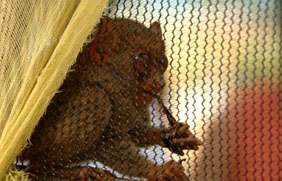
Tarsiers are illegal captured to be sold as pets or to be shown to public. © Pierre Fidenci
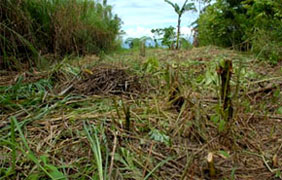
Habitat loss and degradation are the major threats to tarsier. © Endangered Species International
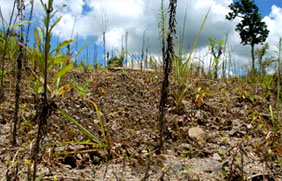
Previous habitat of the tarsier now converted to agriculture in the Philippines. © Pierre Fidenci
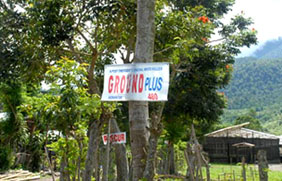
Pesticides have negative impact on tarsier feeding ground. © Endangered Species International
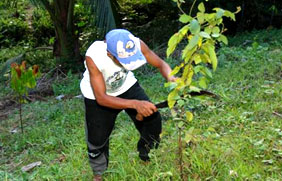
Habitat conservation and restoration: planting native trees protect tarsier. © Pierre Fidenci

Endangered Species International working closely with local communities and local governments to protect tarsier and their habitat. © Endangered Species International
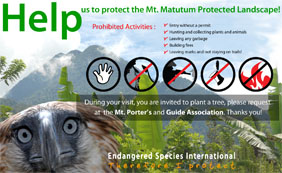
Interpretative sign created by ESI placed in protected area.
|

